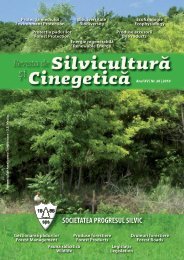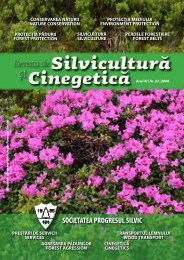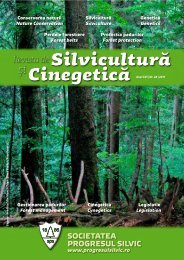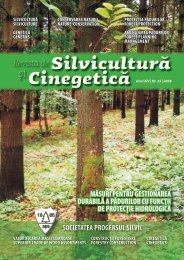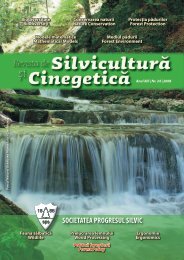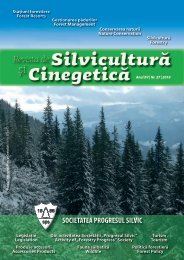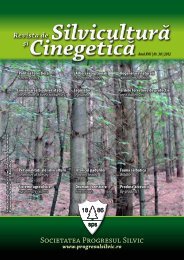Silviculture and Cinegetics Review - Societatea Progresul Silvic
Silviculture and Cinegetics Review - Societatea Progresul Silvic
Silviculture and Cinegetics Review - Societatea Progresul Silvic
You also want an ePaper? Increase the reach of your titles
YUMPU automatically turns print PDFs into web optimized ePapers that Google loves.
FORESTRY BELTS SILVICULTURE AND CINEGETICS REVIEW XVII/30/2012<br />
Although at the beginning of the 20th century our<br />
country, through the shelterbelt programme for<br />
Bărăgan, Ialomiţa <strong>and</strong> Brăila regions, was first<br />
worldwide ranked in this domain, after 1962, the<br />
political regime of that period decided to cut off most<br />
of forest shelterbelts. Only the forest shelterbelts<br />
established by the Romanian foresters in the<br />
Cadrilater (Southern part of the Dobrogea, ceded to<br />
Bulgaria in 1940), in the interwar period, have been<br />
maintained <strong>and</strong> remain functional.<br />
The question of forest shelterbelts in Romania was<br />
returned after 1989, <strong>and</strong> the Law no. 289/2002 create<br />
the legal frame for their establishment (Ianculescu,<br />
2001; ***, 2002a; ***, 2002b).<br />
The paper represents a synthesis of the research<br />
outcomes gathered in the field of the forest<br />
shelterbelts, of the gained experience also of<br />
designing <strong>and</strong> implementation of the forest<br />
shelterbelts, <strong>and</strong> has prevalently approached the<br />
Danube Plain <strong>and</strong> the Dobrogea Plateau, because in<br />
these regions there are signals of degrading processes<br />
of environmental conditions, especially the drying<br />
aspect (Costăchescu <strong>and</strong> Dănescu, 2005, 2006;<br />
Mihăilă, 2006; Dănescu <strong>and</strong> Costăchescu, 2009).<br />
This paper addresses to the experts in agriculture <strong>and</strong><br />
silviculture, the institutions responsible for fundament<br />
agriculture <strong>and</strong> forestry policies, <strong>and</strong> physical <strong>and</strong><br />
juridical person wishing to establish forest<br />
shelterbelts, presenting available solutions to achieve<br />
the forest shelterbelts networks at territorialadministrative<br />
level, based on current conditions:<br />
environmental, l<strong>and</strong> use <strong>and</strong> l<strong>and</strong> register.<br />
2. Materials <strong>and</strong> methods<br />
To establish the forest shelterbelts network at the level<br />
of geographical units discussed (the Danube Plain <strong>and</strong><br />
Dobrogea), based on the results of the previous<br />
research studies that became official by technical<br />
norms, only arable l<strong>and</strong>s <strong>and</strong> pastures were considered<br />
(by orthophotomaps vectorization at 1:5000 scale),<br />
being excluded from the beginning the orchards,<br />
vineyards, built settlements <strong>and</strong>, of course, the l<strong>and</strong>s<br />
covered by forest vegetation. Therefore, it resulted the<br />
total infield area considered for establishment of the<br />
forest shelterbelts network (2.806.989 ha in the<br />
Danube Plain <strong>and</strong> 679.958 ha in Dobrogea).<br />
2.1. Theoretical location of the forest shelterbelts<br />
network in the Danube Plain <strong>and</strong> Dobrogea<br />
In order to adopt the technical solutions to establish<br />
the shelterbelts, it was necessary to framing the<br />
ecological site conditions of the analyzed territory.<br />
During this stage an important phase was the<br />
establishment of the dominant soil types in all<br />
localities, mentioning that the preliminary<br />
classification was made based on the information<br />
provided by the pedological map scale 1:200 000,<br />
carried out by the RIPA (Research Institute of<br />
Pedology <strong>and</strong> Agrochemistry) (***, 1963-1986), over<br />
which were overlapped administrative boundaries of<br />
localities. For this purpose it was necessary the<br />
preliminary geo-reference of the soil map, using ortorectified<br />
aerial images.<br />
The afforestation solutions were established by soil<br />
types <strong>and</strong> soil types groups ecologically similar,<br />
linking the ecological requirements of species with the<br />
ecological soils characteristics. Transfer the<br />
afforestation solutions on the plans was, therefore,<br />
carried out by their association with the soils already<br />
highlighted on the working maps.<br />
Over these layers of diverse information<br />
(geographical, hydrological, pedological, afforestation<br />
solutions, administrative, infrastructure, etc.), was<br />
established the theoretical network of forest<br />
shelterbelts (Figure 1). The network consists of the<br />
main shelterbelts spaced at 600 m <strong>and</strong> secondary<br />
shelterbelts that intersect the main shelterbelts at a<br />
distance of 1200 m (this being the most frequent size<br />
of agriculture plots).<br />
Considering the direction <strong>and</strong> frequency of the<br />
prevailing winds, the main shelterbelts were northsouth<br />
oriented. For reasons related to the necessity to<br />
compensate the protective effect reduction due to the<br />
increasing distances between the shelterbelts (to<br />
distance optimal considered –1000 m x 500 m) by<br />
increasing the width of the secondary shelterbelts, <strong>and</strong><br />
the necessity to simplify the design <strong>and</strong> subsequent<br />
establishment of the network shelterbelts, for the<br />
shelterbelts a unique width of 10 m was adopted.<br />
The theoretical network of shelterbelts was interrupted<br />
in the crossing points with the main communication<br />
ways (railways, highways, national roads <strong>and</strong> county<br />
roads) <strong>and</strong> with the waters (rivers, lakes, ponds).<br />
The network shelterbelts area of localities, l<strong>and</strong> use<br />
categories <strong>and</strong> afforestation solutions were resulted of<br />
overlapping that network over the above-mentioned<br />
information layers, on that basis being further<br />
determined also the required quantity of afforestation<br />
stock.<br />
51



